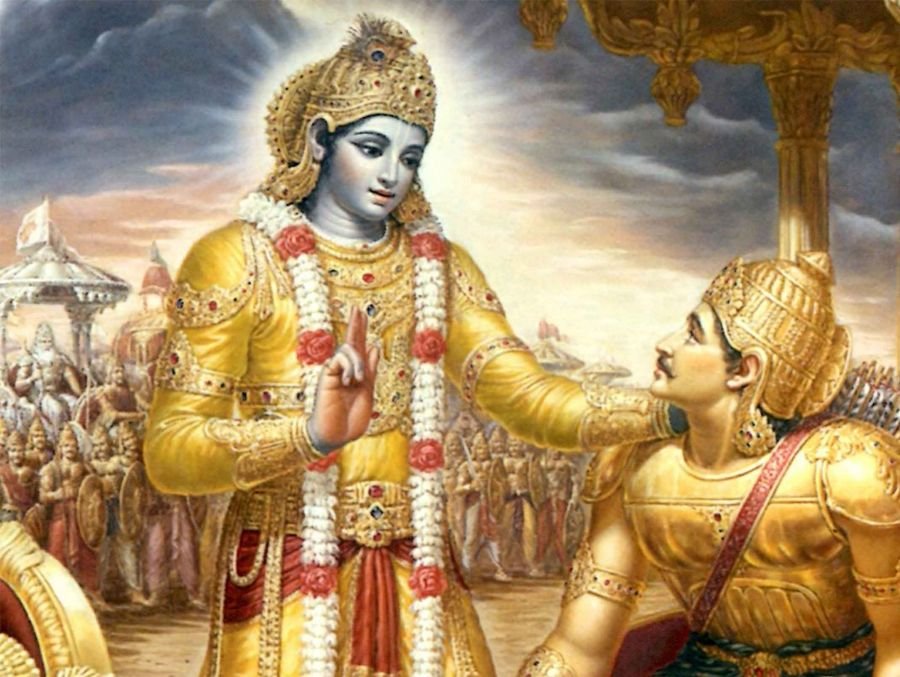(Image Courtesy Mahanidhiswami)
The All-Pervading Formless Brahman And The Personal Form Are Both Manifestations Of God
अर्जुन उवाच |
एवं सततयुक्ता ये भक्तास्त्वां पर्युपासते |
ये चाप्यक्षरमव्यक्तं तेषां के योगवित्तमा: || 12.1||
arjuna uvācha
evaṁ satata-yuktā ye bhaktās tvāṁ paryupāsate
ye chāpy akṣharam avyaktaṁ teṣhāṁ ke yoga-vittamāḥ|| 12.1||
Shloka Translation
BG – Ch. 12- Ver. 1:
Arjuna said: Who is the superior knower of yoga, between Those devotees, constantly united in you; worship you, and those devotees who worship the imperishable, the unmanifest?
Explanation
Arjuna saw the Lord in his cosmic form, which encompassed the entire cosmos, in the previous chapter. He liked to view God in His own form, with Attributes, Qualities, and Pastimes, after seeing it. As a result, he is now intrigued as to whether devotees who worship the personal form of God or those who worship the impersonal Brahman are more flawless.
Arjun’s question reaffirms God’s dual nature: the all-pervading formless Brahman and the human form. Those who believe God cannot have a personal form limit Him, as do those who believe God only exists in a personal form. God is both formless and possessing forms since He is flawless and complete. We, as individuals, have both characteristics.
Both personal and impersonal is the Supreme Being. Devotees of the formless Brahman and devotees of the personal form are two types of spiritual practitioners. However, worshipping the formless is a difficult route to take.
Verse & what we can learn
The first chapter of the Gita dealt with Arjuna’s bewilderment as a result of his lack of identity and his inability to understand his role on the battlefield. Chapters two through five discussed the true essence of an individual and how to purify oneself using karma yoga. The yoga of meditation taught in Chapter 6 how to stay in touch with one’s true nature at all times. Ishvara was described in detail in chapters seven through ten, culminating in the vision of the cosmic form in chapter eleven.
This chapter focuses on bhakti yoga, or yoga of devotion to Ishvara. “Perform acts for me,” “get loyal to me,” and “make me your greatest objective,” Shri Krishna says throughout the Gita. But first, we must determine who this “me” is who is to be worshipped. Shri Krishna has defined himself as imperishable, unmanifest, and invisible to our senses at times in the Gita. In the previous chapter, Krishna revealed his visible cosmic form to Arjuna.
So, Arjuna is curious as to who is the superior devotee. Is it the worshipper of the manifest or the worshipper of the unmanifest? Saguna refers to someone who has characteristics and can be seen and felt. Nirguna means “without qualities.” Shri Krishna has a difficult decision. In the next shloka, he responds to the query.
To acquire knowledge and to implement that knowledge in life one needs to be mentally and physically active and healthy and for that daily meditation is a great tool.
There are various types of meditation like Buddhist meditation, heartfulness meditation, mindfulness meditation, meditation for stress, and each meditation benefits are countless. There is also numerous meditation techniques for beginners which help in practicing daily meditation so go ahead and start your journey towards a peaceful and balanced life.
In the next Shloka Shri Krishna tells Arjuna about those people who are superior in yoga.
Let’s learn to live with “The Gita” via Meditation Affinity…
